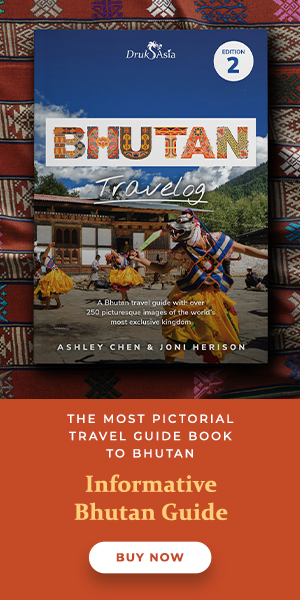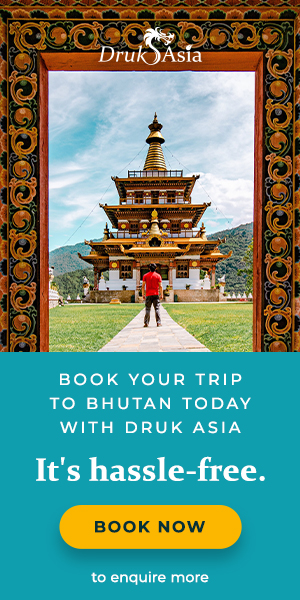Launch of the Textile Museum Website and the Virtual Exhibitions
Her Majesty the Queen Mother Gyalyum Sangay Choden Wangchuck, Royal Patron of the Textile Museum, Department of Culture, Ministry of Home and Cultural Affairs has officially launched the virtual exhibition and the website of the Textile Museum today the 21st of February, 2021 to commemorate the 41st Birth Anniversary of His Majesty the King Druk Gyalpo Jigme Khesar Namgyel Wangchuck.
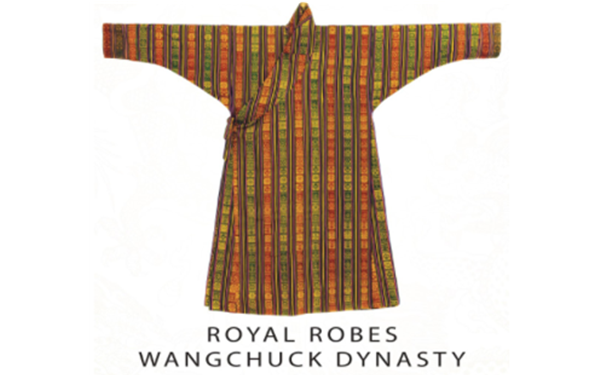
The COVID-19 pandemic has affected us all globally, resulting in disruptions that restrict the movement of people and public gatherings. In order to prevent the spread of the novel coronavirus, the Government of Bhutan has closed down its borders and has imposed travel restrictions which has affected the tourism industry tremendously.
In response to the current situation while adjusting to the new normal of conducting most activities online, a platform has been developed to provide national and international textile enthusiasts access to the current exhibitions titled ‘Thagzo- The Art of Weaving’ and ‘Royal robes-Wangchuck Dynasty’.
The website www.textilemuseum.bt has been developed with a login option and online payment systems. This virtual tour is the first of its kind in this tiny himalayan nation which is an amalgamation of the ancient art of weaving with the new age of digital technology. The virtual exhibition provides a 3-D experience of the museum galleries and detailed information on the artifacts on display from your personal space.
To celebrate the birth anniversary of His Majesty the King, the virtual exhibitions can be accessed free of cost from the 21st of February 2021 to the 21st of March, 2021.
Thagzo- The Art of Weaving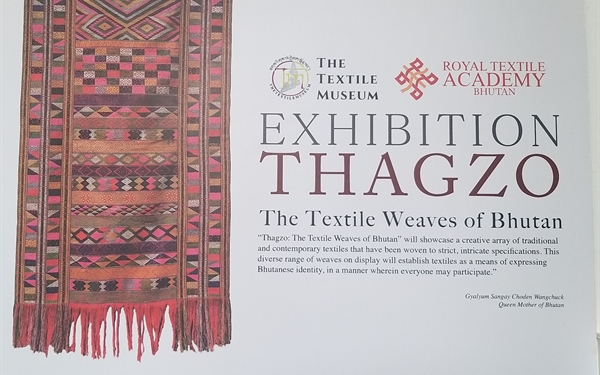
‘Thagzo- The Art of Weaving’ will showcase a creative array of traditional and contemporary textiles that have been woven to strict, intricate specifications. This diverse range of weaves on display will establish textiles as a means of expressing Bhutanese identity, in a manner wherein everyone may participate.
Cloth as Wealth, Tax and Gift
Hand woven cloth has held an important place in the economy throughout the history of Bhutan. Traditionally, cloth was considered a form of ‘junor’ or wealth and until the barter system fell into disuse by the twentieth century, cloth was often used as a form of currency.
Textiles specifically woven for payment of taxes are often referred to as ‘thag-threl’, tax cloth which is different from the ones woven for personal and family use. Tax cloth was used as payment of family and community taxes to the dzongs, for gifts for neighboring states, and for state distribution to officials and monasteries.
The practice of offering ‘zog’ or presentation of cloth as gifts is followed to this day during ceremonial, religious and festive occasions.
Masterpieces from the loom
The importance of the woven textile in the culture of Bhutan is evident to any visitor to the Kingdom. On formal occasions and tshechus, religious festivals, the exquisite hand-woven textiles can be seen in all their colorful splendor, as everyone dresses in their very best garments displaying the latest innovations of the weaver’s skill in patterning and choice of colours, or some wear precious robes in classical weaves handed down for generations in their families.
Bhutanese textiles have been inspired by mundane everyday sights that have been portrayed in resplendent weaves by their creators, in which the weavers meticulously incorporate the meaning of nature, religion and life as a whole in Bhutan. The designs used are intricate and varied. Some resemble embroidery and their names are descriptive of the natural world observed by the weaver. They include ‘pigeon’s eye’, rooster’s comb’; monkey’s nails’, fly’s wings’ and so on.
Our textiles have developed into an art form through the ages from the plain weaves with the occasional hint of color serving the primary purpose of basic clothing. Today, Bhutanese textiles are one of the finest examples of our textiles woven on a common back strap loom which dates back to the late 1800’s and horizontal frame looms that were later introduced sometime in the early 1960’s.
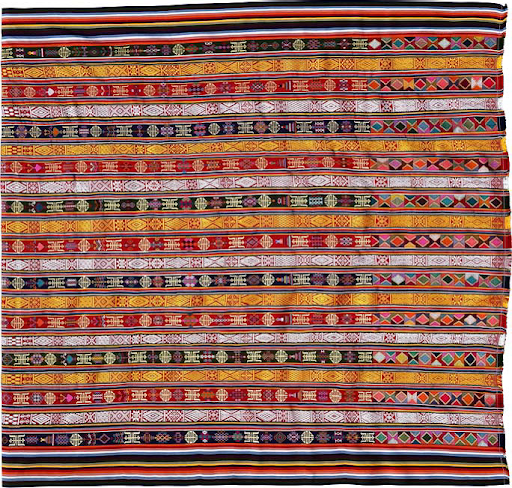
The aikapur singlochem kira was repopularized in 2011 when Her Majesty the Queen Gyaltsuen Jetsun Pema Wangchuck wore a similar kira during the royal wedding to His Majesty the King Jigme Khesar Namgyel Wangchuck.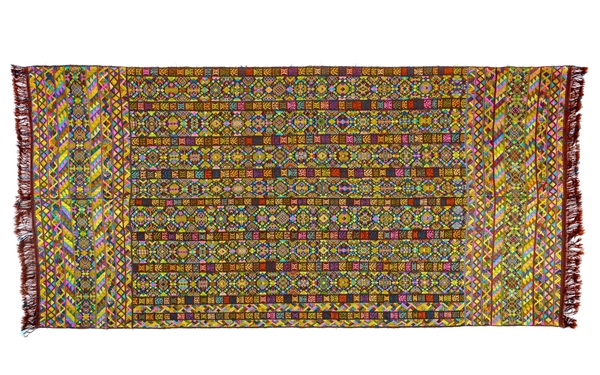
The 2012 National Design and Art Competition’s award winning kushuthara.
Kushuthara
For the last one hundred years or so one of the most treasured textiles used for a woman’s dress is the kushuthara which is traditionally woven on a white background embellished with intricate patterns woven on a discontinuous supplementary weft brocade design. Today, kushutharas are woven in many colors due to the availability of imported silks from India and China. The design was developed in Kurtoe in north-central Bhutan, the original home of the royal family and popularized by the ladies of the royal household.
Ngosham
Ngosham is a variation of the kushuthara which had developed during the past century under the patronage of the Bhutanese royalty. The royal families in eastern and central districts of Kurtoe and Bumthang engaged a number of skilled weavers, master dyers, and yarn processors amongst the palace staff.
Aikapur
Aikapur, the supplementary warp patterned cloth is traditionally woven out of bura (wild silk) or cultivated silk and occasionally of cotton. It is the cloth of choice for men as the aikapur is to a man’s dress as a kushuthara is to a woman’s dress. Prized by Bhutanese for generations, the classic supplementary weft patterned weave has been the cloth of distinction saved for special occasions.
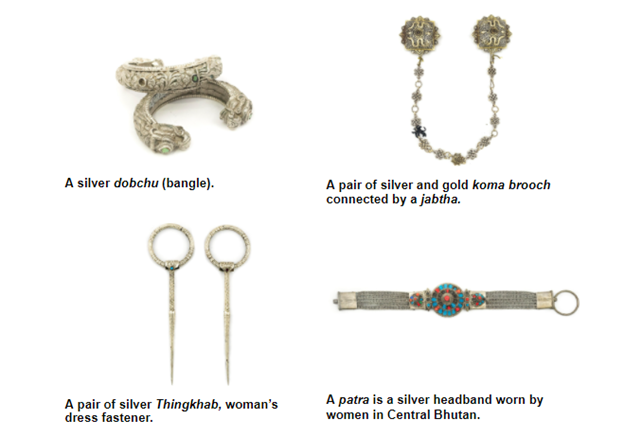
Ornaments
Thingkhab - Brooches shaped like a long pin were originally used by the women as dress fasteners, and necklaces were attached to the large rings to balance the weight. The thingkhab is now obsolete and has given way to a more contemporary version called the koma. The Koma is a brooch used to fasten a kira. It is either cast out of gold or silver chased with floral patterns and auspicious symbols. A pair of koma is connected by a silver necklace called the jabtha which hangs up to the chest and is connected by silver rings and floral designs. A Dobchu is a bangle (usually made of ivory, gold, gilded gold or silver) that is engraved with auspicious symbols or floral motifs. The Sinchu is a traditional Bhutanese earring that resembles a teardrop or floral design with turquoise embedment attached to a ring that goes through the ear. The Patra - designed into floral motifs with turquoise embedment links with silver chains, patras are headband worn by the women in central Bhutan before the introduction of Buddhism when Bon religion was still practiced in Bhutan.
Regional Costumes
There are numerous ethnic communities in Bhutan which can be classified into four major groups. The Ngalop of western and northern Bhutan; the Lhotshampa concentrated in southern Bhutan; the Sharshop of eastern Bhutan; and the Bhutanese tribal and aboriginal peoples living in villages scattered throughout Bhutan.
Many of these ethnic groups have maintained their distinct cultural identities through their dress, language, and traditions over the years.
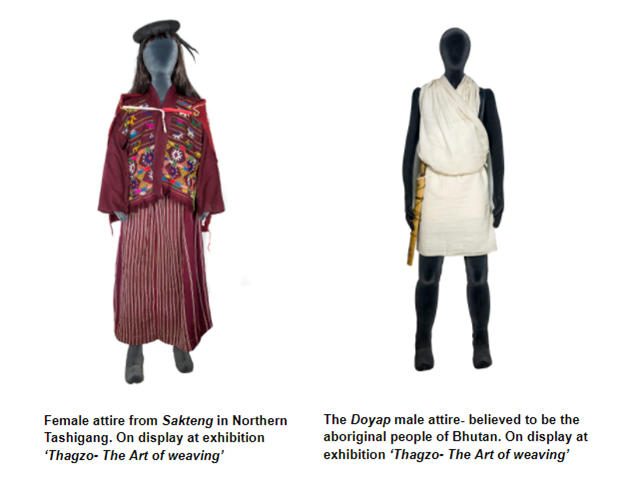
Royal Robes - Wangchuck Dynasty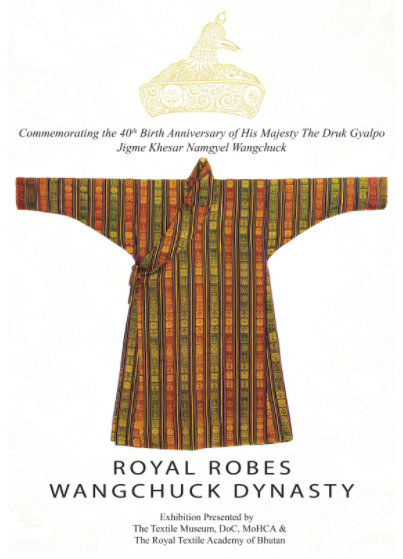
The thematic exhibition ‘Royal robes - Wangchuck Dynasty’ showcases exquisite textiles worn by the kings and members of the Wangchuck Dynasty - past and present. On display are magnificent textiles belonging to members of the Royal Family from the namza of monarchs, queens, princes and princesses to crowns and accessories of the Wangchuck dynasty which include donations from Their Majesties the Kings, Her Majesty the Royal Grandmother Kesang Choden Wangchuck and Her Majesty the Queen Mother Gyalyum Sangay Choden Wangchuck, Royal Patron of the Textile Museum.
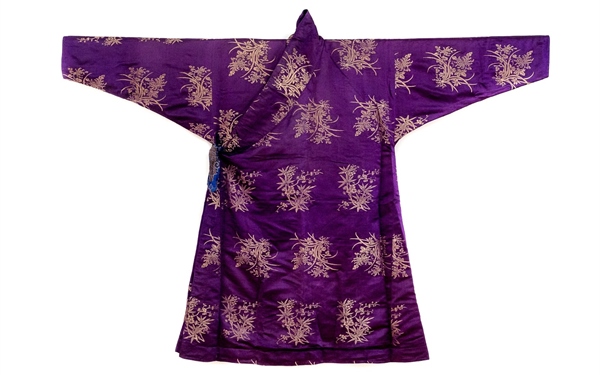
Silk Brocade Namza belonged to His Majesty the First King of Bhutan Gongsar Ugyen Wangchuck. On display at the exhibition ‘Royal Robes- Wangchuck Dynasty’
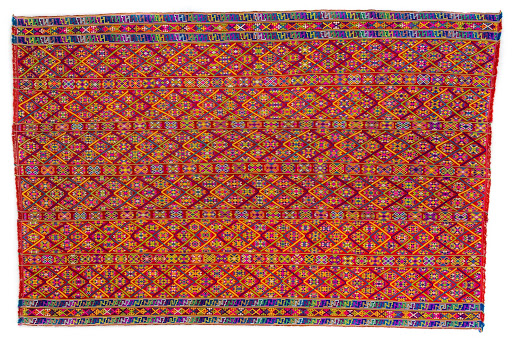
Namza Kira donated to the Textile Museum by the Royal Patron Her Majesty the Queen Mother Gyalyum Sangay Choden Wangchuck. On display at the exhibition ‘Wangchuck Dynasty-Royal Robes’
